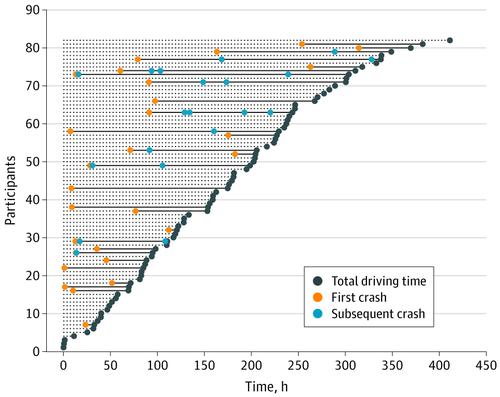当前位置:
X-MOL 学术
›
JAMA Pediatr.
›
论文详情
Our official English website, www.x-mol.net, welcomes your
feedback! (Note: you will need to create a separate account there.)
Learner Driver Experience and Teenagers’ Crash Risk During the First Year of Independent Driving
JAMA Pediatrics ( IF 24.7 ) Pub Date : 2020-06-01 , DOI: 10.1001/jamapediatrics.2020.0208 Johnathon P Ehsani 1 , Pnina Gershon 2 , Brydon J B Grant 3 , Chunming Zhu 4 , Sheila G Klauer 5 , Tom A Dingus 5 , Bruce G Simons-Morton 4
JAMA Pediatrics ( IF 24.7 ) Pub Date : 2020-06-01 , DOI: 10.1001/jamapediatrics.2020.0208 Johnathon P Ehsani 1 , Pnina Gershon 2 , Brydon J B Grant 3 , Chunming Zhu 4 , Sheila G Klauer 5 , Tom A Dingus 5 , Bruce G Simons-Morton 4
Affiliation

|
Importance
One mechanism for teenagers' elevated crash risk during independent driving may be inadequate learner driving experience. Objective
To determine how learner driver experience was associated with crash risk during the first year of independent driving. Design, Setting, and Participants
Youth aged 15.5 to 16.1 years at recruitment were eligible to participate. Participants' vehicles were instrumented with sensors, and driving was recorded during the learner period through 1 year of independent driving. Data were collected from January 2011 through August 2014 in southwestern Virginia. Exposures
The amount, consistency and variety of practice, driving errors, and kinematic risky driving (KRD) rates during the learner period were recorded. Surveys, including one on sensation-seeking personality traits, were assessed at baseline. Main Outcomes and Measures
Cox proportional hazard regressions examined associations between individual characteristics and learner driving experience with driving time to first crash and all crashes in the first year of independent driving. So that hazard ratios (HRs) can be directly comparable, units of measurement were standardized to the interquartile range. Results
Of 298 individuals who responded to recruitment, 90 fulfilled the criteria and 82 completed the study (of whom 75 were white [91%] and 44 were girls [54%]). Teenage participants drove a mean (SD) of 1259.2 (939.7) miles over 89 days during the learner period. There were 49 property-damage crashes and/or police-reportable crashes during independent driving. Factors associated with driving time to first crash included higher sensation-seeking personality scale scores (HR, 1.67 [95% CI, 1.08-2.57] per 0.75-unit increase), learner driving KRD rates (HR, 1.27 [95% CI, 1.12-1.43] per 9.24-unit increase), and learner driving errors (HR, 0.44 [95% CI, 0.22-0.86] per increase of 6.48 errors). Similar results were obtained for all crashes in the first year, with the addition of consistency of learner driving practice (HR, 0.61 [95% CI, 0.38-0.99] per 0.23-unit increase). Conclusions and Relevance
Individual characteristics and learner driving experiences were associated with crash risk during independent driving. As expected, there was an association between sensation seeking and crashes. Elevated KRD rates during the learner period may reflect risky driving behavior among novices or tolerance to abrupt maneuvers by parents who supervise driving. Consistent practice throughout the learner period could reduce teenage crash risk, which is supported by learning theories indicating distributed practice is effective for developing expertise. Errors during practice may constitute learning events that reinforce safer driving. Physicians could encourage parents to provide opportunities for regular practice driving and monitor their teenager's KRD rates during the learner period using in-vehicle or smartphone-based technology.
中文翻译:

独立驾驶第一年学习驾驶体验与青少年碰撞风险
重要性 青少年独立驾驶时碰撞风险升高的一种机制可能是学习驾驶经验不足。目的 确定在独立驾驶的第一年,学习驾驶经验与碰撞风险之间的关系。设计、设置和参与者 招募时 15.5 至 16.1 岁的青年有资格参与。参与者的车辆配备了传感器,并在学习期间通过 1 年的独立驾驶记录了驾驶情况。数据是从 2011 年 1 月到 2014 年 8 月在弗吉尼亚州西南部收集的。暴露 记录学习者期间练习的数量、一致性和多样性、驾驶错误和运动学风险驾驶 (KRD) 率。在基线时评估了调查,包括一项关于寻求感觉的人格特质的调查。主要结果和措施 Cox 比例风险回归检验了个体特征和学习者驾驶经验与首次碰撞的驾驶时间和独立驾驶第一年的所有碰撞之间的关联。为了使风险比 (HR) 可以直接进行比较,测量单位被标准化为四分位距。结果 在 298 名对招募有反应的人中,90 人符合标准,82 人完成了研究(其中 75 人是白人 [91%],44 人是女孩 [54%])。在学习期间,青少年参与者在 89 天内平均驾驶 (SD) 为 1259.2 (939.7) 英里。独立驾驶期间发生了 49 起财产损失事故和/或警方应报告的事故。与第一次碰撞的驾驶时间相关的因素包括更高的追求感觉人格量表分数(HR,1. 67 [95% CI,1.08-2.57] 每 0.75 单位增加),学习者驾驶 KRD 率(HR,1.27 [95% CI,1.12-1.43] 每 9.24 单位增加),和学习者驾驶错误(HR,0.44 [ 95% CI, 0.22-0.86] 每增加 6.48 个错误)。第一年的所有碰撞都获得了类似的结果,增加了学习者驾驶实践的一致性(HR,0.61 [95% CI,0.38-0.99] 每 0.23 单位增加)。结论和相关性个人特征和学习驾驶经验与独立驾驶期间的碰撞风险相关。正如预期的那样,感觉寻求和崩溃之间存在关联。学习者期间 KRD 率升高可能反映了新手的危险驾驶行为或对监督驾驶的父母的突然操作的容忍度。在整个学习期间坚持练习可以降低青少年崩溃的风险,这一点得到了学习理论的支持,表明分布式练习对于发展专业知识是有效的。练习中的错误可能构成加强安全驾驶的学习事件。医生可以鼓励父母提供定期练习驾驶的机会,并在学习期间使用车载或基于智能手机的技术监控青少年的 KRD 率。
更新日期:2020-06-01
中文翻译:

独立驾驶第一年学习驾驶体验与青少年碰撞风险
重要性 青少年独立驾驶时碰撞风险升高的一种机制可能是学习驾驶经验不足。目的 确定在独立驾驶的第一年,学习驾驶经验与碰撞风险之间的关系。设计、设置和参与者 招募时 15.5 至 16.1 岁的青年有资格参与。参与者的车辆配备了传感器,并在学习期间通过 1 年的独立驾驶记录了驾驶情况。数据是从 2011 年 1 月到 2014 年 8 月在弗吉尼亚州西南部收集的。暴露 记录学习者期间练习的数量、一致性和多样性、驾驶错误和运动学风险驾驶 (KRD) 率。在基线时评估了调查,包括一项关于寻求感觉的人格特质的调查。主要结果和措施 Cox 比例风险回归检验了个体特征和学习者驾驶经验与首次碰撞的驾驶时间和独立驾驶第一年的所有碰撞之间的关联。为了使风险比 (HR) 可以直接进行比较,测量单位被标准化为四分位距。结果 在 298 名对招募有反应的人中,90 人符合标准,82 人完成了研究(其中 75 人是白人 [91%],44 人是女孩 [54%])。在学习期间,青少年参与者在 89 天内平均驾驶 (SD) 为 1259.2 (939.7) 英里。独立驾驶期间发生了 49 起财产损失事故和/或警方应报告的事故。与第一次碰撞的驾驶时间相关的因素包括更高的追求感觉人格量表分数(HR,1. 67 [95% CI,1.08-2.57] 每 0.75 单位增加),学习者驾驶 KRD 率(HR,1.27 [95% CI,1.12-1.43] 每 9.24 单位增加),和学习者驾驶错误(HR,0.44 [ 95% CI, 0.22-0.86] 每增加 6.48 个错误)。第一年的所有碰撞都获得了类似的结果,增加了学习者驾驶实践的一致性(HR,0.61 [95% CI,0.38-0.99] 每 0.23 单位增加)。结论和相关性个人特征和学习驾驶经验与独立驾驶期间的碰撞风险相关。正如预期的那样,感觉寻求和崩溃之间存在关联。学习者期间 KRD 率升高可能反映了新手的危险驾驶行为或对监督驾驶的父母的突然操作的容忍度。在整个学习期间坚持练习可以降低青少年崩溃的风险,这一点得到了学习理论的支持,表明分布式练习对于发展专业知识是有效的。练习中的错误可能构成加强安全驾驶的学习事件。医生可以鼓励父母提供定期练习驾驶的机会,并在学习期间使用车载或基于智能手机的技术监控青少年的 KRD 率。









































 京公网安备 11010802027423号
京公网安备 11010802027423号